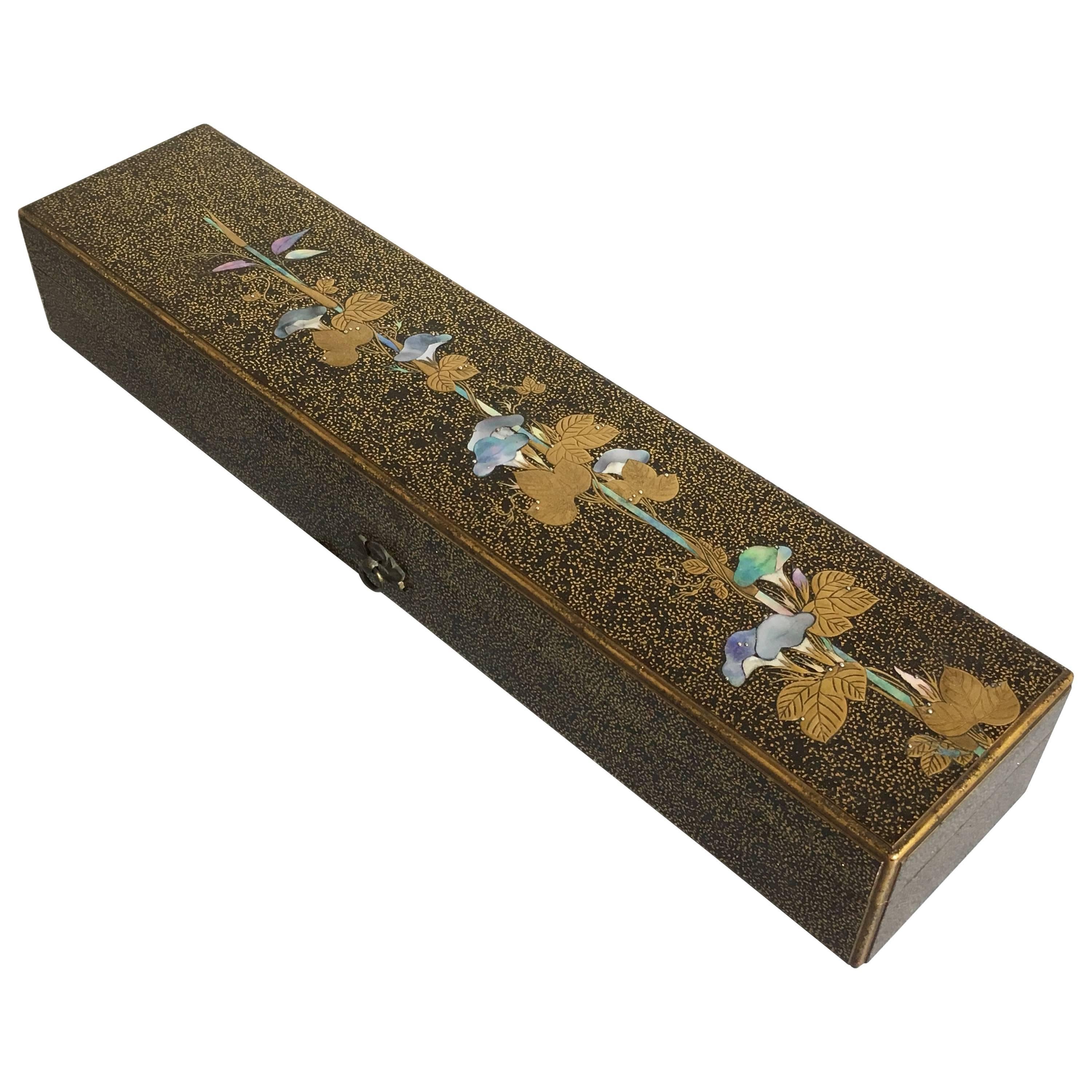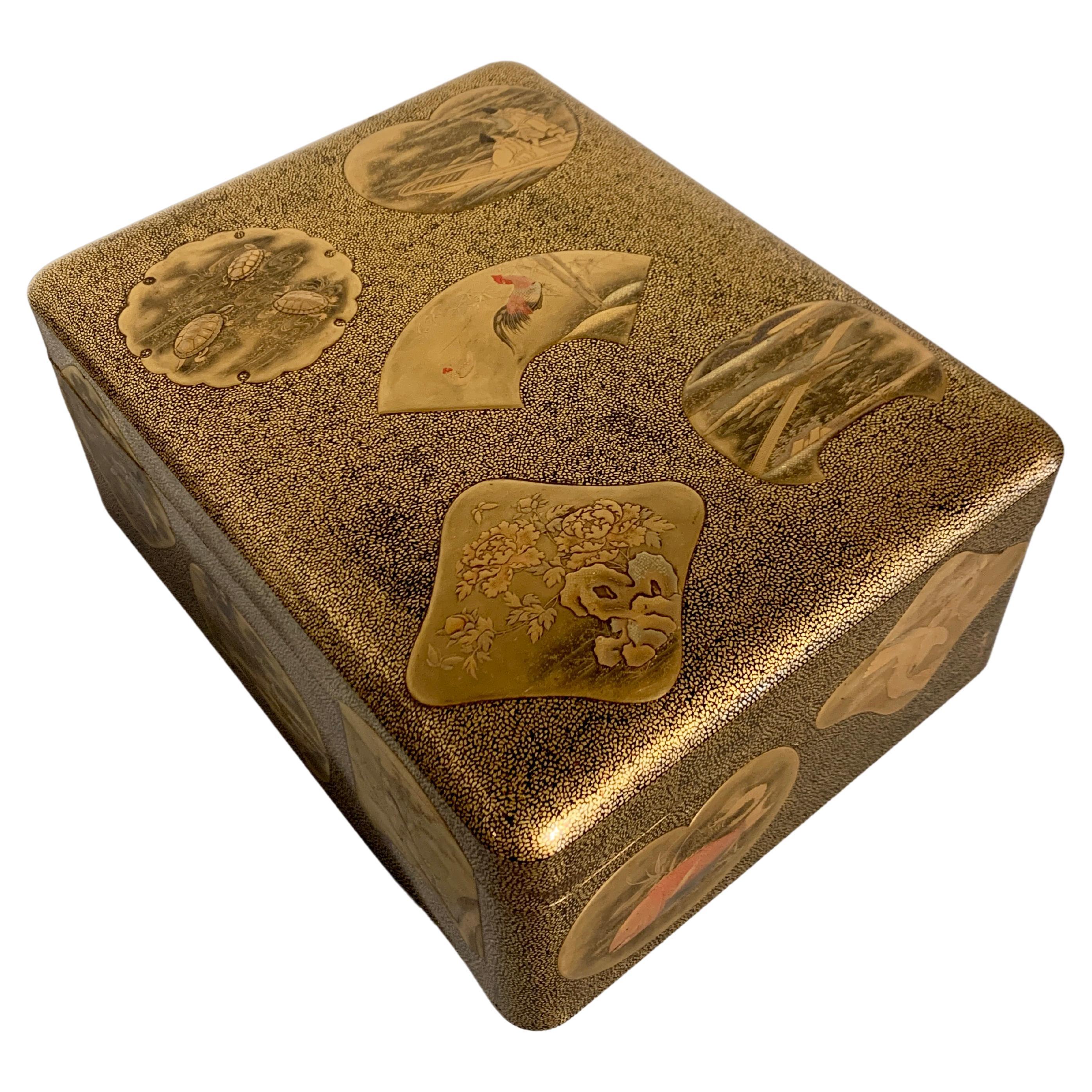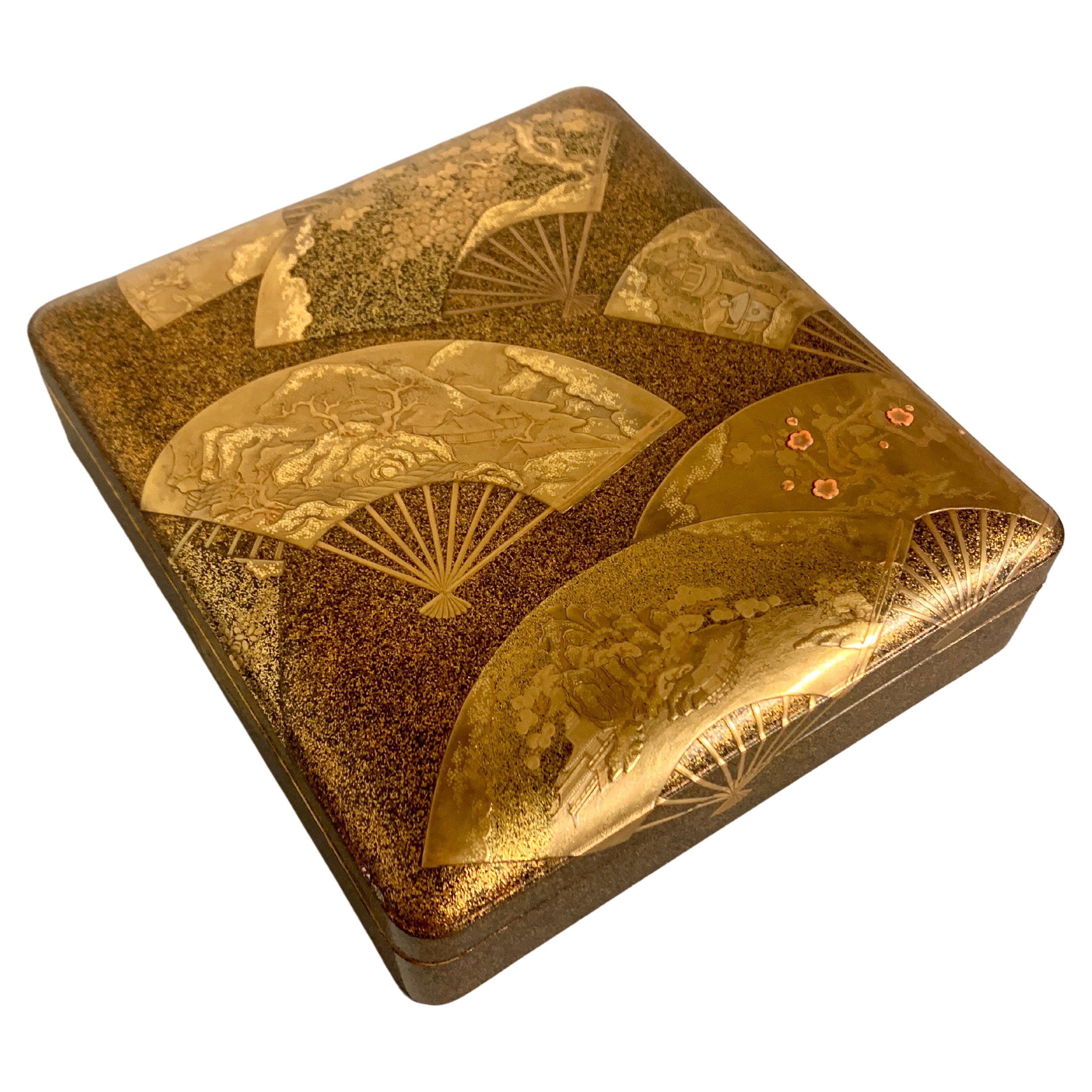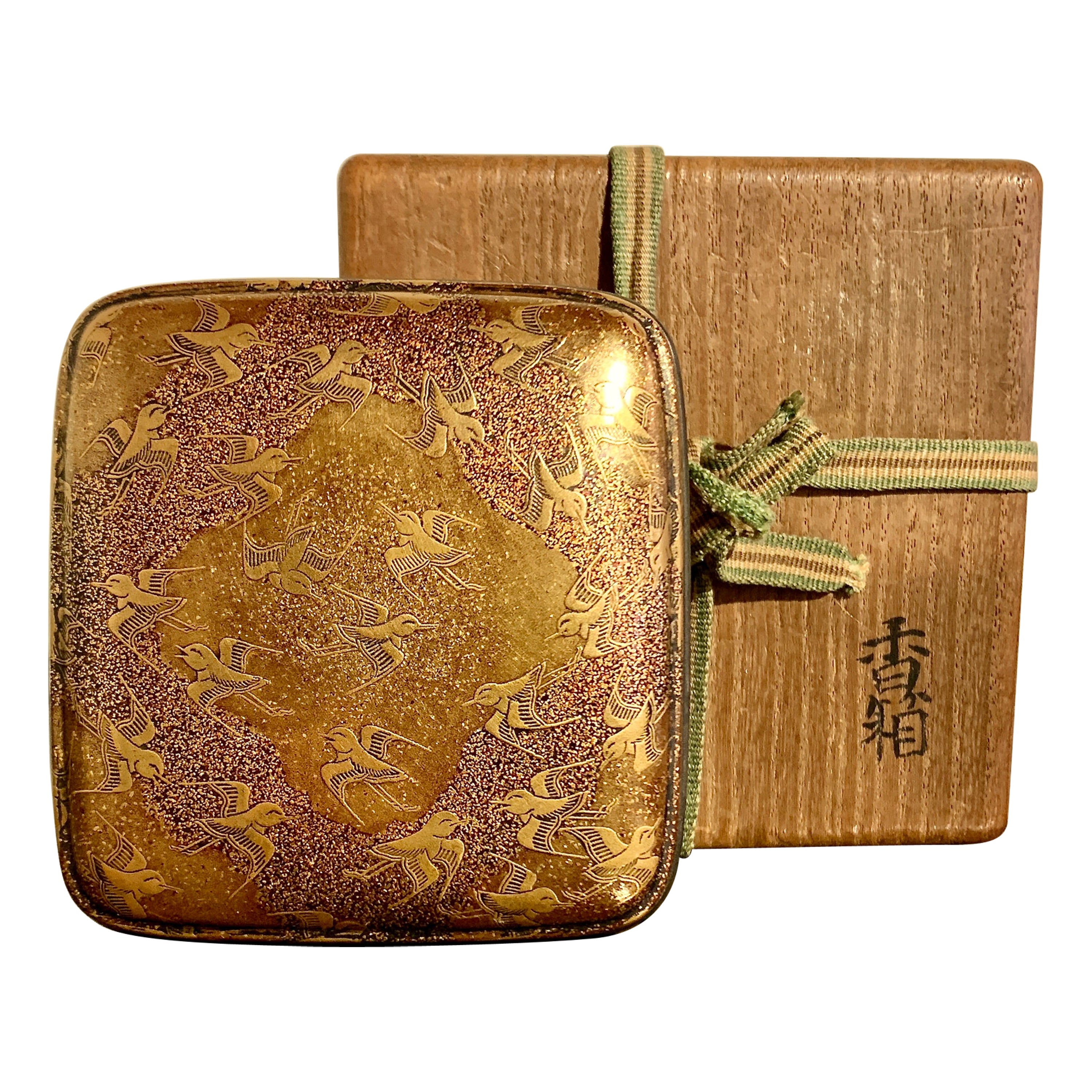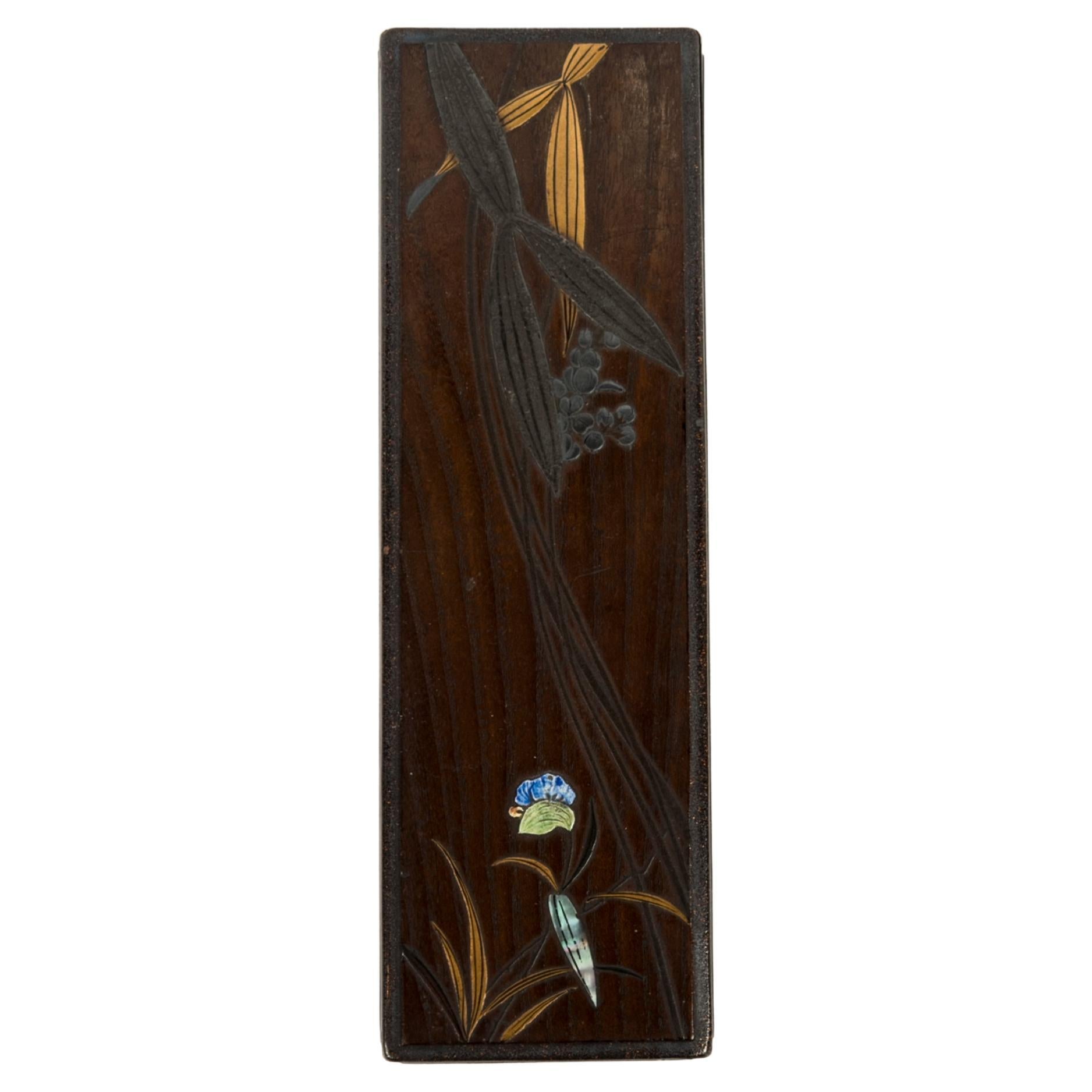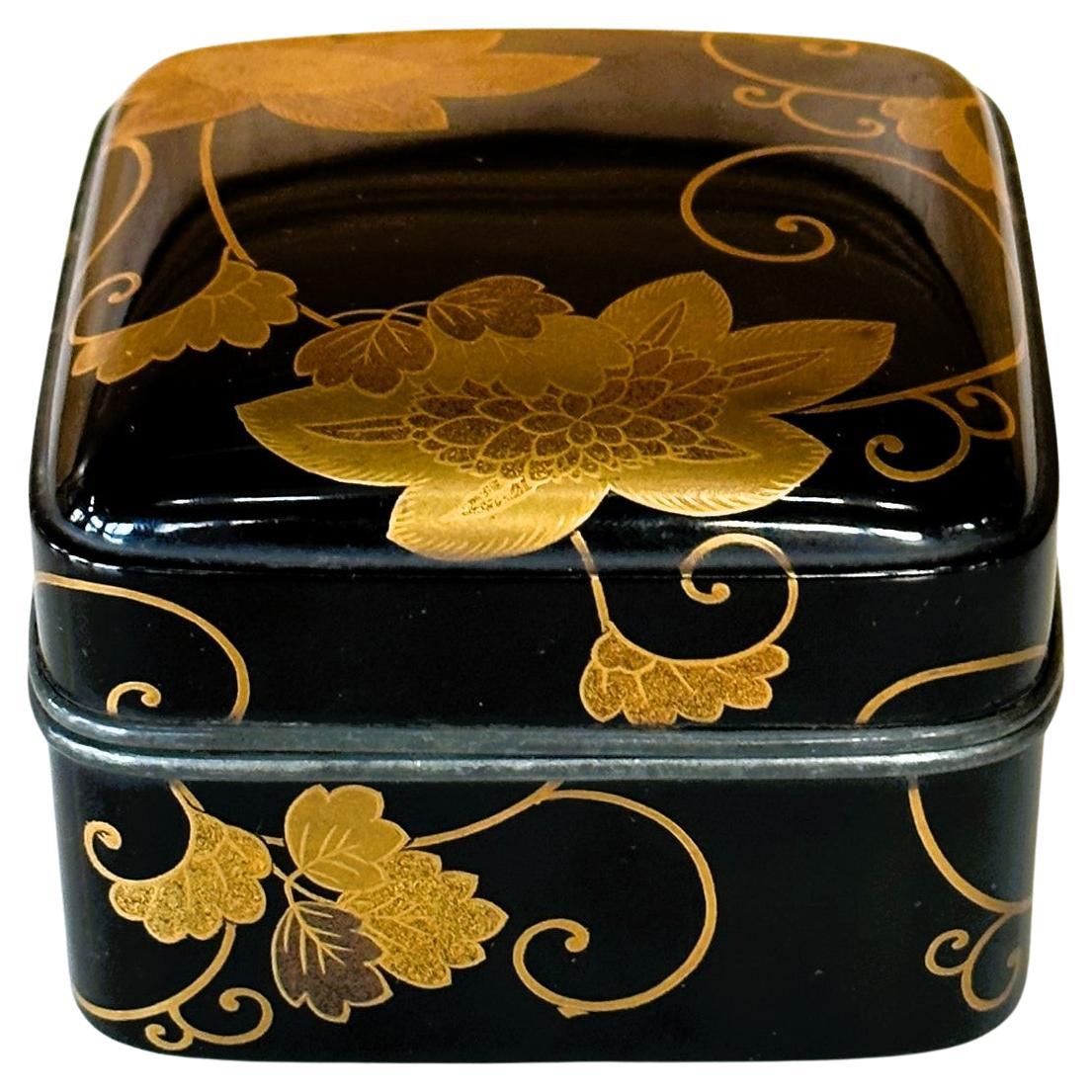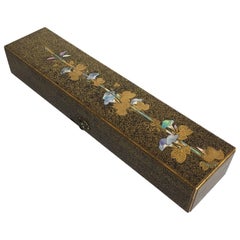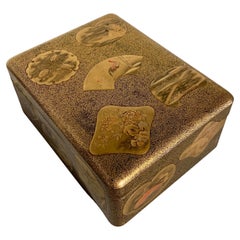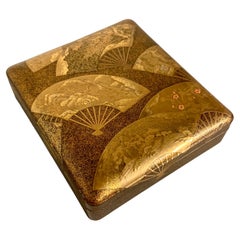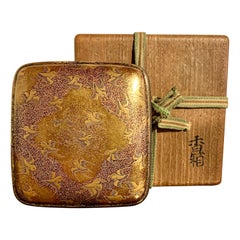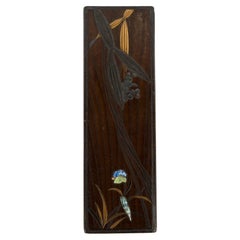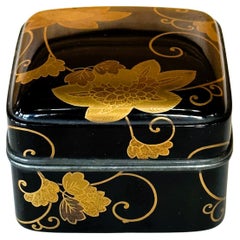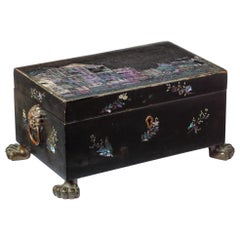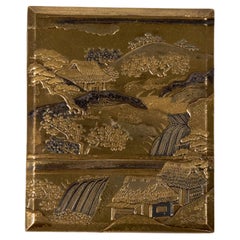Items Similar to Japanese Rinpa Lacquer Box, "Irises at Yatsuhashi", by Santo Kyosui, Edo Period
Want more images or videos?
Request additional images or videos from the seller
1 of 12
Japanese Rinpa Lacquer Box, "Irises at Yatsuhashi", by Santo Kyosui, Edo Period
$6,500
£4,935.60
€5,644.23
CA$9,081.44
A$10,100.55
CHF 5,274.19
MX$122,912.91
NOK 67,359.47
SEK 63,171.30
DKK 42,125.06
Shipping
Retrieving quote...The 1stDibs Promise:
Authenticity Guarantee,
Money-Back Guarantee,
24-Hour Cancellation
About the Item
A very special Japanese Rinpa style small lacquer box for incense accessories, kobako, by Santo Kyosui (1816 to 1867), late Edo period (1603 to 1868), mid 19th century, Kyoto, Japan.
The delicate lacquer box features a highly unusual dark green lacquer ground, and is designed with a scene often referred to as "Irises at Yatsuhashi" or "Eight Bridges".
The bold and oversized irises of gold, silver, and copper raised hira-maki-e, with the zig-zagging plank bridges in deep reddish brown polished lacquer and a rougher copper . The support posts, crafted in rough high relief taka-maki-e, are in stark contrast to the polished planks and irises.
The title of the scene comes from a section of The Tales of Ise in which the protagonist, Ariwara no Narihira, and his companions take a break from their long journey. They find themselves sitting by the famous iris marshes of Mikawa Province and the famous zig-zagging eight plank-bridges. It is here that Ariwara no Narihira composes his famous poem lamenting his long separation from his wife during his exile and travels.
The composition is very much in line with the Rinpa school, focused on nature and offering bold, new perspectives. The design of the box was almost certainly influenced by Ogata Korin's famous pair of screens "Irises at Yatsuhashi".
The box is extremely lightweight, weighing in at only 30 grams. The base of the box seems to be either paper or a very thin shaved wood.
Signed "Kyosui zo" (made by Kyosui) for Santo Kyosui (1816 to 1867), a well regarded Japanese painter and maki-e lacquer artist of the later Edo period.
- Dimensions:Height: 2 in (5.08 cm)Width: 3 in (7.62 cm)Depth: 3.75 in (9.53 cm)
- Style:Edo (Of the Period)
- Materials and Techniques:
- Place of Origin:
- Period:
- Date of Manufacture:early to mid 19th century
- Condition:Wear consistent with age and use. In overall very good condition. Some texture to the lacquer - possibly from age, or possibly intentional.
- Seller Location:Austin, TX
- Reference Number:1stDibs: LU894742086412
About the Seller
5.0
Platinum Seller
Premium sellers with a 4.7+ rating and 24-hour response times
Established in 2001
1stDibs seller since 2010
345 sales on 1stDibs
Typical response time: <1 hour
- ShippingRetrieving quote...Shipping from: Austin, TX
- Return Policy
Authenticity Guarantee
In the unlikely event there’s an issue with an item’s authenticity, contact us within 1 year for a full refund. DetailsMoney-Back Guarantee
If your item is not as described, is damaged in transit, or does not arrive, contact us within 7 days for a full refund. Details24-Hour Cancellation
You have a 24-hour grace period in which to reconsider your purchase, with no questions asked.Vetted Professional Sellers
Our world-class sellers must adhere to strict standards for service and quality, maintaining the integrity of our listings.Price-Match Guarantee
If you find that a seller listed the same item for a lower price elsewhere, we’ll match it.Trusted Global Delivery
Our best-in-class carrier network provides specialized shipping options worldwide, including custom delivery.More From This Seller
View AllJapanese Edo Period Igarashi School Long Lacquer Box, Tanzaku-Bako
Located in Austin, TX
A stunning Japanese Edo period lacquer tanzakubako, box for poem cards, late 18th-early 19th century, Edo Period, Japan.
Attributed to the Igarashi School, this box is masterfully ...
Category
Antique Early 19th Century Japanese Edo Lacquer
Materials
Mother-of-Pearl, Lacquer
Large Japanese Lacquer Document Box, Ryoshibako, Edo/Meiji period, Japan
Located in Austin, TX
A large and magnificently decorated Japanese lacquer document box, ryoshibako, signed Umeboshi/Baikyo, late Edo or early Meiji Period, mid 19th century, Japan.
The large document box, ryoshibako, of tall, rectangular shape with rounded corners, and fitted with an inrobuta (flush-fitting) cover with beveled edges. The exterior of this exquisite box is decorated all over with fifteen different raised reserves shaped as uchiwa (paddle) fans against a lush and intricate krikane ground imitating shagreen.
The uchiwa shaped reserves all of takamaki-e, and exquisitely painted with designs of animals, flowers, and landscapes in silver, gold, maki-e, hiramaki-e, and takamaki-e, with kirikane, nashiji, and polychrome embellishments, upon gold lacquer fudame grounds.
The interior of the lid is nothing short of spectacular, featuring a large design of a magnificent and beautifully detailed rooster and hen with chicks gathered around a lazy stream. Large stalks of chrysanthemum bloom behind them. All against an ethereal nashiji ground.
The cover of the box features five reserves:
1. Three minogame (turtles with long tails), symbolizing longevity
2. "Narihira Crossing the Sumida" from The Tales of Ise...
Category
Antique 1860s Japanese Meiji Lacquer
Materials
Softwood, Lacquer
Japanese Maki-e Lacquer Document Box, Edo Period, early 19th Century, Japan
Located in Austin, TX
A spectacular Japanese maki-e lacquer lidded box, possibly a writing box, suzuribako, decorated with images of folding fans, ogi, Edo Period, earl...
Category
Antique Early 19th Century Japanese Edo Lacquer
Materials
Coral
Japanese Lacquer Incense Box, Kogo, Momoyama or Edo Period, 16th/17th Century
Located in Austin, TX
A wonderful Japanese lacquer incense box, kogo, with a design of plovers in flight, late Momoyama or early Edo Period, circa 1600, Japan.
The small box, called a kogo, was used to s...
Category
Antique Early 17th Century Japanese Edo Lacquer
Materials
Gold, Pewter
Japanese Stacking Incense Box, Ju-Kobako, Meiji Period, Mid 19th century, Japan
Located in Austin, TX
An exquisite small Japanese maki-e lacquer stacking box for incense and accessories, ju-kobako, late Edo or early Meiji Period, mid 19th century, Japan.
Crafted in maki-e lacquer an...
Category
Antique Mid-19th Century Japanese Meiji Lacquer
Materials
Silver
Japanese Lacquer Box, Kogo, Tale of Genji, Edo Period, early 19th century, Japan
Located in Austin, TX
A fine Japanese small lacquer box for precious incense, kogo, Edo period, mid 19th century, Japan.
The small box of gold lacquer and wonderfully dec...
Category
Antique Early 19th Century Japanese Edo Lacquer
Materials
Pewter
You May Also Like
Japanese fudebako or brush box in lacquered hardwood and ceramic inlay
Located in PARIS, FR
Brush box (fudebako) is made of wood and lacquer. On the lid, lacquer decoration representing sagittarius, a flower inlaid with ceramic and a leaf inlaid (raden).
Interior and base o...
Category
Early 20th Century Japanese Taisho Lacquer
Materials
Gold
Antique Japanese Lacquered Incense Box Kobako in Kodaiji Style
Located in Atlanta, GA
An antique lacquered small box that was likely used to contain incense powder (it is called Kobako in Japanese), circa early to mid-19th century of the Edo...
Category
Antique 19th Century Japanese Edo Lacquer
Materials
Wood, Lacquer
Japanese Nagasaki Export Lacquer Box with Depiction of the 'Trippenhuis'
Located in Amsterdam, NL
A Japanese Nagasaki export lacquer box with mother-of-pearl depiction of the Amsterdam ‘Trippenhuis’
Edo-period, circa 1830
H. 12.5 x W. 24...
Category
Antique 19th Century Japanese Edo Lacquer
Materials
Mother-of-Pearl, Lacquer
Japan lake landscape kobako box lacquer - Edo
Located in PARIS, FR
Rectangular kobako box in takamaki-e and kirigane gold lacquer circled with pewter depicting a lake landscape. Inside and back of the box in nashi-ji lacquer.
Japan – Edo period (16...
Category
Antique 18th Century Japanese Lacquer
Materials
Gold
Intricately Carved Kamakura Lacquer Box with Botanical Design by Tamerou Ono
Located in Prahran, Victoria
A vintage Japanese Tsuzuri bako, writing box. with an unusual, deeply carved relief of Japanese sarcandra glabra, a woody herbal sub-shrub native to Asia with deep green glossy leave...
Category
Mid-20th Century Japanese Lacquer
Materials
Wood
Japanese landscape pine kobako box Edo period 18th century
Located in PARIS, FR
Rectangular black and gold lacquer kobako box decorated with pine trees in a mountain landscape in takamaki-e, kirigane and hiramaki-e lacquer. Background in nashi-ji lacquer. Surmou...
Category
Antique 18th Century Japanese Lacquer
Materials
Gold
More Ways To Browse
Antique Lacquer Box
Antique Lacquer Boxes
Japanese Lacquer Boxes
Edo Period Gold
Antique Iris
Iris Gold
Antique Santos
Antique Post Box
Antique Artist Paint Box
Polish Tapestry
Japanese Iris
Japanese Screen Kyoto
19th Century Painted Tapestry
Green Japanese Screen
Green Lacquer Box
Antique Japanese Lacquer Screens
Antique Japanese Silver Box
Silver Antique Japanese Boxes Silver Boxes
